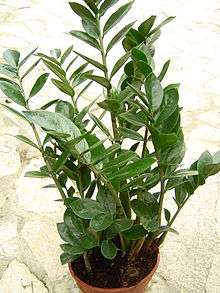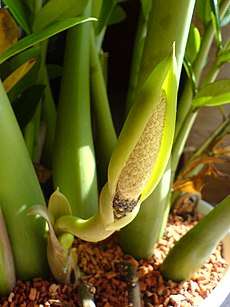Zamioculcas
Zamioculcas (common names Zanzibar gem, ZZ plant, Zuzu plant, aroid palm,[2] eternity plant or emerald palm[3]) is a genus of flowering plant in the family Araceae, containing the single species Zamioculcas zamiifolia. It is a tropical perennial plant native to eastern Africa, from southern Kenya to northeastern South Africa. Zamioculcas is grown as an ornamental plant, mainly for its attractive glossy foliage and easy care.
| Zamioculcas | |
|---|---|
 | |
| A cultivated specimen | |
| Scientific classification | |
| Kingdom: | Plantae |
| Clade: | Tracheophytes |
| Clade: | Angiosperms |
| Clade: | Monocots |
| Order: | Alismatales |
| Family: | Araceae |
| Subfamily: | Zamioculcadoideae |
| Genus: | Zamioculcas Schott |
| Species: | Z. zamiifolia |
| Binomial name | |
| Zamioculcas zamiifolia (Lodd.) Engl.[1] | |
Dutch nurseries started wide-scale commercial propagation of the plant around 1996.[4] It was first described as Caladium zamiifolium by Loddiges in 1829, moved to his new genus Zamioculcas by Heinrich Wilhelm Schott and given its established name Zamioculcas zamiifolia by Adolf Engler.
Etymology
The botanical name derives from on the one hand the superficial similarity of its foliage to that of the cycad genus Zamia and on the other hand its kinship to the genus Colocasia, whose name comes from a word culcas or colcas in a Middle Eastern language of antiquity[5] and which is named qolqas (Egyptian Arabic: قلقاس, IPA: [ʔolˈʔæːs]) in Arabic.[6] Botanical synonyms include Caladium zamiaefolium, Zamioculcas loddigesii and Z. lanceolata.
Description

It is a herbaceous plant growing to 45–60 centimetres (17.7–23.6 in) tall, from a stout underground, succulent rhizome. It is normally evergreen, but becomes deciduous during drought, surviving drought due to the large potato-like rhizome that stores water until rainfall resumes. The leaves are pinnate, 40–60 centimetres (15.7–23.6 in) long, with 6–8 pairs of leaflets 7–15 centimetres (2.8–5.9 in) long; they are smooth, shiny, and dark green. The stems of these pinnate leaves are thickened at the bottom.
The flowers are produced in a small bright yellow to brown or bronze spadix 5–7 centimetres (2.0–2.8 in) long, partly hidden among the leaf bases; flowering is from mid summer to early autumn.
Zamioculcas zamiifolia contains an unusually high water contents of leaves (91%) and petioles (95%)[7] and has an individual leaf longevity of at least six months, which may be the reason it can survive extremely well under interior low light levels for four months without water.[8]
Cultivation

It may survive outdoors as long as the temperature does not fall below around 15°C (59°F); though best growth is between 18°C to 26°C (65° to 79°F) while hot temperatures give an increase of leaf production. In temperate regions, it is grown as a houseplant. Over watering may destroy this plant through tuber rot. Bright, indirect light is best for Zamioculcas: some sun will be tolerated.[8]
Zamioculcas zamiifolia may be propagated by leaf cuttings: typically, the lower ends of detached leaves are inserted into a moist gritty compost and the pot enclosed in a polythene bag. Though the leaves may well decay, succulent bulb-like structures should form in the compost and these may be potted up to produce new plants. The process may take upwards of one year. The plant can also be propagated by division. The plant impresses especially by the thick, dark green, shiny leaves. Due to its strong green leaves, it is especially suitable for open, bright rooms.[9]
Usage in traditional medicine
Though little information is available, Z. zamiifolia is apparently used medicinally in the Mulanje District of Malawi and in the East Usambara mountains of Tanzania where juice from the leaves is used to treat earache.[10]
In Tanzania a poultice of bruised plant material from Z. zamiifolia is used as a treatment of the inflammatory condition known as "mshipa".[11]
Roots from Z. zamiifolia are used as a local application to treat ulceration by the Sukuma people in north-western Tanzania.[12]
Chemicals
Zamioculcas zamiifolia contains acylated C-glycosylflavone apigenin 6-C-(6″-O-(3-hydroxy-3-methylglutaroyl)- β-glucopyranoside)[7]
Air purification
The plant has air purifying qualities for the indoor environment. A Study from Department of Plant and Environmental Science at the University of Copenhagen from 2014 shows the plant is able to remove volatile organic compounds in this order of effectiveness: benzene, toluene, ethylbenzene and xylene at a molar flux of around 0.01 mol/(m2 day).[13]
Toxicity
Zamioculcas zamiifolia is part of the family Araceae, which includes many poisonous genera, such as Philodendron, which contains calcium oxalate.
An initial toxicological experiment conducted by the University of Bergen in 2015 on extracts from Z. zamiifolia using brine shrimp as a lethality assay did not indicate lethality to the shrimp even at concentrations of extracts up to 1 mg/mL. The scientists conducting the experiment found that "On the contrary, it could appear as though the extract contributed to improvements in the vitality of the larvae".[7]
References
- "Zamioculcas zamiifolia". Germplasm Resources Information Network (GRIN). Agricultural Research Service (ARS), United States Department of Agriculture (USDA). Retrieved 2008-03-24.
- ZZ Plant, Zamioculcas Zamiifolia, Aroid Palm- How To Grow And Care
- Administrator. "Zamioculcas - EMERALD PALM". www.royalgreen.nl.
- Catherine, Horwood (2007). Potted History: The Story of Plants in the Home. Frances Lincoln Ltd. p. 173. ISBN 978-0-7112-2800-9.
- "Colocasia". Flora of North America. Retrieved August 4, 2018.
- "Colcasia قلقاس". egyptian-cuisine-recipes.com. Retrieved August 4, 2018..
- Moullec, Angharad (October 2015). "First identification of natural products from the African medicinal plant Zamioculcas zamiifolia — A drought resistant survivor through millions of years". Fitoterapia. 106: 280–285. doi:10.1016/j.fitote.2015.09.011.
- Chen, Jianjun; Henny, Richard (September 2003). "ZZ: A Unique Tropical Ornamental Foliage Plant". HortTechnology. 13 (3): 458–462. doi:10.21273/horttech.13.3.0458. Retrieved 14 March 2016.
- L'Ami des Jardins (ed.): Climatic plants in the house: Healthy living with detoxifying houseplants . Bassermann Verlag, Munich 2012, ISBN 978-3-641-67900-2 , p. 20
- Beentje, Henk (1985). Flora of Tropical East Africa - Araceae (1985). CRC Press. p. 15. ISBN 9061913225.
- Watt, J.M.; Breyer-Brandwijk, M.G. (1962). The Medicinal and Poisonous Plants of Southern and Eastern Africa, Being and Account of Their Medicinal and Other Uses, Chemical Composition, Pharmacological Effects and Toxicology in Man and Animal. E. & S. Livingstone Ltd.
- P.R.O., Bally (26 October 1937). "Native Medicinal and Poisonous Plants of East Africa". Bulletin of Miscellaneous Information. 1937 (1): 10–26. doi:10.2307/4107637. JSTOR 4107637.
- Dela Cruz, Majbrit; Christensen, Jan H.; Thomsen, Jane Dyrhauge; Müller, Renate (19 June 2014). "Can ornamental potted plants remove volatile organic compounds from indoor air? — areview" (PDF). Environmental Science and Pollution Research. 21 (24): 13909–13928. doi:10.1007/s11356-014-3240-x. PMID 25056742. Retrieved 14 March 2016.
External links

